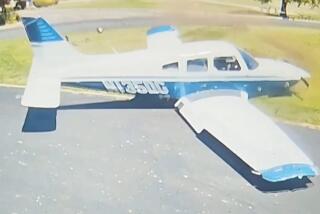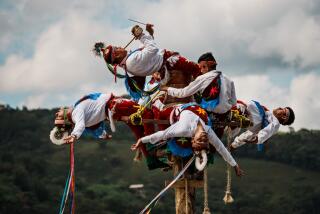Fledgling Fliers Struggle to Get Off the Ground : Speed and Sweat Helps Students Become Airborne
- Share via
Preparing for his maiden flight in a para-glider, Fillmore dentist Mark Pratt stands on a Simi Valley training hill awaiting orders from instructor Randy Liggett.
Pratt is strapped into a harness, which is connected by dozens of 400-pound-test lines to a nylon canopy spread out on the ground behind him. When the wind spurts to five or six miles an hour, Pratt yanks the lines, filling cells along the canopy’s leading edge with air and bringing the glider to life.
Struggling to maintain his balance as the glider pops up above his head, Pratt gets the go-ahead from Liggett: “Run, run, run, run, run!”
Pratt charges down the hill, his progress impeded by the billowing canopy, which acts like a helium-filled parade float bucking in the wind. Wobbling off course, he tramples the tall grass but gets enough lift to raise his feet and fly.
Pratt’s flight time: five seconds. Highest altitude: 18 inches. Distance: 20 feet. The Wright Brothers had more success at Kitty Hawk, but Pratt is enthralled by his gravity-defying feat.
“It was great while it lasted,” he says, trudging back up the hill with the canopy bunched in his arms.
Practice makes perfect in a sport that has no tolerance for imperfection. In para-gliding, a beginner needs at least five lessons before attempting a high-altitude flight; getting the hang of hang gliding requires about 20 lessons. Costs for lessons range from $300 to $1,000 a week.
After completing their lessons, beginners can take a test to become certified by the U.S. Hang-Gliding Assn. Although the gliding sports are not regulated by the Federal Aviation Administration and pilots don’t need a license, USHGA certification is almost mandatory to buy equipment and use launch sites.
The eight prime sites in the county are policed by safety-conscious local pilots who “won’t let you fly if they think you don’t know what you’re doing,” says Achim Hageman, who owns a glider shop in Santa Barbara. “The last thing the sport needs is some fool getting into an accident.”
The USHGA requires beginners to learn from certified instructors, who are a rare breed in Ventura County: Liggett is the county’s only certified para-gliding instructor.
The gentle slope in Simi Valley, the only bunny hill around, is the rookery for novices from Ventura, Los Angeles and Santa Barbara counties. After signing liability waivers and learning about wind direction, beginners get into a harness and start down the hill under the watchful eye of an instructor.
“Stop! Stop!” Liggett yells at Frank Fox, a 27-year-old Oxnard truck driver who is on a collision course with a wind indicator fluttering from a pole.
Fox flattens the pole. “You did everything right, Frank,” Liggett says, “except for hitting that pole.”
Although para-gliders are less expensive than hang gliders--$3,000 versus $4,500 for top-of-the-line equipment--they wear out faster. Buying a used glider isn’t recommended because the technology changes every year.
“A para-glider over 4 years old is an antique,” Hageman says. “If you spend $1,000 for one you’re getting a piece of junk.”


